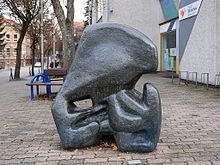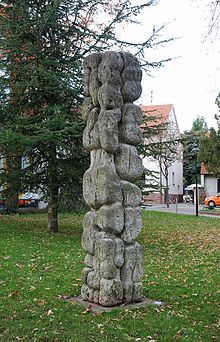László Szabó (sculptor)

László Szabó (born September 8, 1917 in Debrecen , † December 17, 1984 in Ravenel near Paris ) was a Hungarian - French sculptor .
Life
Szabó first studied law in Debrecen, later he attended an officers' school. In 1944 he fled from the communists to Switzerland, where he first stayed in Lausanne before studying at the art school in Geneva with Max Weber and Henry Koenig. A scholarship took Szabó to Paris in 1947, where he attracted attention by setting up a cave house.
Even if the prevailing housing shortage may have given the impetus, a new design for architecture was seen in the rounded shapes and curved walls: a fusion of sculpture and architecture. Szabó's three-dimensional studio in the Rue Daguerre, the so-called Académie du Feu , developed into a meeting place and workplace for numerous artists. Up to 15 artists lived there at times, some of them for years. Le Corbusier was impressed when he visited the caves in 1948 and was influenced by it when he built his famous Ronchamp church in 1950.
From 1949 Szabó exhibited regularly in the Salon de la Jeune Sculpture, from 1951 also in the Salon des Réalités Nouvelles . Szabó had his first solo exhibition in 1953 at the Galerie Breteau, Paris. Szabó exhibited, also in Paris, with Henry Moore , Henri Laurens and Constantin Brâncuși (1956) and with Max Ernst , Pablo Picasso and Germaine Richier (1963).
At the Olympic Sculpture Competition in Munich, Szabó won first prize in 1972, and his fountain sculpture Flying Fish was installed in the Olympic Village in Munich for a long time . In 1976 he designed various buildings on Lanzarote . Szabó made a pilgrimage to the indigenous peoples and lived together with the Eskimos in the far north in 1953.
plant


Szabó calls his work "sun god", "primal animal", "tree of life" or "fertility". The organically growing, swelling forms can evoke associations with prehistoric idols. His sculptures and sculptures radiate vitality. Szabó imagined that in this way people could come back into contact with cosmic forces.
“The art lies deep beneath the surface. The art lies in the middle. Under the color, under the form, in the artist's conception of the world, in his conception of the future of man "
Szabó always modeled his sculptures in clay first. Then he had them poured or carved in stone. For the latter, he worked with a workshop in Budapest, which especially made communist monuments for Eastern Europe. In addition, he had an unlimited entry permit for Hungary. The Danube limestone that Szabó liked to use comes from Eszergon (Danube Bend, western Hungary). Many of his sculptures are made in such a way that they offer interesting views from different directions.
Works in public space (selection)
- 1956 Tree of Life , shell limestone. Wiesloch
- 1966 mother animal with young , bronze. Wiesloch
- 1967 Firebird , bronze. Wiesloch
- 1969 Flying fish . Millennium Sculpture Park inaugurated in September 2001 next to the House of Culture, Hajdúszoboszló / Hungary
- 1972 Tree of Life . Mainz
- 1968–73 sun god . Munich
- 1968–73 Sun God II . Luisenpark , Mannheim
- 1968-73 La Vie . Gutersloh
- 1975 Bright life . Villa Rothschild , Koenigstein
Exhibitions (selection)
- 1959 International Biennale of Sculpture, Carrara / Italy; Biennale of Florence / Italy
- 1959–60 Salon de Mai (Museé d´Art Moderne), Paris
- 1960 Museé de Toulon
- 1962 Exposition des Petits Bronzes (Museé d'Art Moderne), Paris
- 1964 and 1965 Salon de Mai (Museé d'Art Moderne de la Ville de Paris)
- 1968 Court Gallery, Copenhagen; New Art Center, Hamburg; Museo National, Budapest
- 1968–75 Museé d'Art Moderne, Paris
- 1973 Kunsthalle Mannheim, Museum Mainz
- 1975 Museum Heidelberg, Institut Francais
- 1976 Wiesloch Culture House (organized by the Wiesloch Adult Education Center)
- 1976 I Certamen Internacional Artes Plásticas (with Picasso, Miró, Tapies, Bacon, Vasarely, Chillida, Moore and Giacomett), Lanzarote
- 1978 Municipal Gallery Würzburg
Individual evidence
- ↑ a b László Szabó - Sculpture as Potential Architecture , exhibition catalog, Städtische Galerie Würzburg, March 31 to April 30, 1978.
- ^ Tree of Life , László Szabó - City of Wiesloch
- ↑ animal mother with boys , László Szabó - City Wiesloch
- ↑ Big Firebird , László Szabó - City of Wiesloch
- ↑ Luisenpark Mannheim
literature
- László Szabó - Sculpture as Potential Architecture , exhibition catalog, Städtische Galerie Würzburg, March 31 to April 30, 1978.
- László Szabó - sculpture from the years 1946 - 1973 . Exhibition catalog, Kunsthalle Mannheim , May 12 to June 11, 1973.
- Roland Heinzmann: Lászlo Szabó on the hundredth birthday. In: Kurpfälzer Winzerfest 2017 (The MAGAZINE for the festival), Nussbaum Medien, St. Leon-Rot 2017, pp. 62–65.
Web links
- László Szabó - City of Wiesloch
- Figure and abstraction - Sculptures from the Heinrich Vetter Collection (PDF; 7.7 MB) - Sculptures in the park of the Villa Vetter and the Vetter-Stift, Ilvesheim
| personal data | |
|---|---|
| SURNAME | Szabó, László |
| BRIEF DESCRIPTION | Hungarian-French sculptor |
| DATE OF BIRTH | September 8, 1917 |
| PLACE OF BIRTH | Debrecen |
| DATE OF DEATH | 17th December 1984 |
| Place of death | Ravenel |